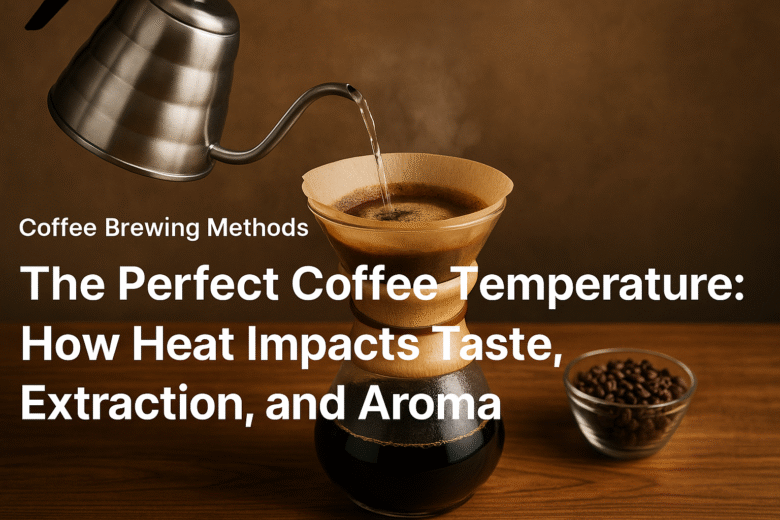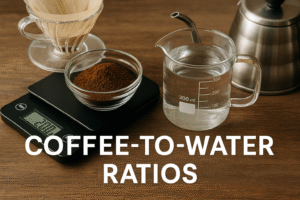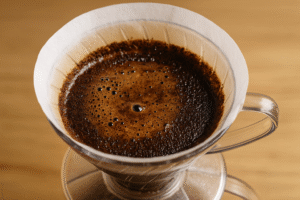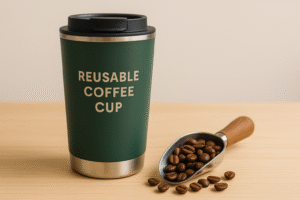Most people focus on beans, grind size, and equipment—but there’s one variable that might be quietly ruining your brew: temperature. It’s easy to overlook, but water that’s too hot or too cold can completely change how your coffee tastes.
The perfect cup isn’t just about good coffee—it’s about extracting the right flavors, at the right time, using water at the right temperature. That’s what transforms your routine into a real coffee experience.
In this expanded guide, we’ll explore how water temperature impacts extraction, the ideal range for each method, common mistakes, tips for temperature control, and how heat affects flavor development across roasts.
Why Water Temperature Matters
Water is the engine of coffee brewing. Its temperature controls how efficiently flavor compounds are extracted from the ground coffee.
Too hot? You pull out bitterness and dull the more subtle notes.
Too cool? You under-extract, resulting in weak, sour coffee with no sweetness or complexity.
The goal is to hit the sweet spot where acids, sugars, and aromatic compounds are extracted in balance, giving your coffee depth, clarity, and satisfaction.
What’s the Ideal Brewing Temperature?
The Specialty Coffee Association recommends a range of 90°C to 96°C (195°F to 205°F) for optimal coffee extraction. Within this window, you get efficient flavor release without bitterness or damage to the more delicate compounds.
If water is below 85°C (185°F), extraction becomes inconsistent. If it’s above 96°C (205°F), you risk burning the grounds and pulling out harsh, dry compounds.
Brew Method Temperature Guidelines
Each brew method interacts with temperature differently. Here’s how to match heat with method
French Press
Ideal Temp: 93°C to 96°C
Tips: Preheat the press to keep temp stable. Cooler temps lead to sourness.
Pour-Over (V60, Chemex, Kalita)
Ideal Temp: 90°C to 95°C
Tips: Lighter roasts benefit from hotter water (94–96°C). Darker roasts may taste burnt at high temps—drop to 90°C.
AeroPress
Ideal Temp: 80°C to 95°C
Tips: Use cooler water (80–85°C) for a smooth cup. Hotter water (90–95°C) for stronger extraction.
Espresso
Ideal Temp: 88°C to 96°C (controlled by machine)
Tips: Temperature stability is critical. Small changes can dramatically affect taste. Good machines allow temp tuning.
Moka Pot
Temp is regulated by stovetop heat
Tips: Use preheated water to control pressure and avoid metallic bitterness from overheating.
Cold Brew
No heat
Tips: Brew with cold or room temperature water. Takes 12–24 hours to extract flavors slowly and gently.
Drip Coffee Makers
Ideal Temp: 92°C to 96°C (if quality machine)
Tips: Most budget models brew too cool. Look for SCA-certified machines for proper temperature control.
How Roast Level Affects Temperature Needs
Light Roasts
Denser and harder to extract
Use hotter water (94–96°C) to break open cell structure and extract full complexity
Highlight acidity and floral notes
Medium Roasts
Balanced and versatile
Ideal around 92–94°C
Sweetness and body are well-developed
Dark Roasts
More porous and easier to extract
Use cooler water (88–92°C)
Too much heat brings out bitterness and smoky harshness
How to Measure Water Temperature Without a Thermometer
Let water boil, then rest:
30 seconds = ~96°C
60 seconds = ~93°C
90 seconds = ~90°C
If you don’t have a thermometer, boiling and resting is a reliable method for consistent results. Just don’t pour boiling water directly on your coffee—it’s too aggressive.
Temperature and Flavor Development
Higher Temperatures
Faster extraction
Boosts bitterness and body
Can flatten complex acids and overdevelop roasts
Lower Temperatures
Slower extraction
Highlights brightness and delicacy
Can lead to sourness if under-extracted
Taste is personal—so play within the range and see what fits your palate.
Common Temperature Mistakes
Using Boiling Water
Boiling water is 100°C and can scald the grounds, especially dark roasts. Always wait 30 seconds after boiling.
Cold Equipment
Pouring hot water into a cold French press, Chemex, or mug drops temperature fast. Preheat everything to keep your brew stable.
Using Cheap Electric Kettles
Many kettles don’t stop boiling immediately or have poor insulation. Consider investing in a temperature-controlled kettle for consistency.
Not Adjusting for Room Temperature
Brewing in a cold kitchen? Your water will cool faster, especially in metal or ceramic brewers.
Ignoring Roast Type
Dark roasts + high temps = bitterness. Always reduce temperature slightly for dark beans.
Tools to Help Control Temperature
Gooseneck Kettle with Temperature Control
Allows precise heat control down to the degree. Great for pour-over and AeroPress.
Basic Digital Thermometer
Affordable and accurate. Use to measure water after boil or inside your brewer.
Variable Temperature Electric Kettle
Set your exact desired temperature. Essential for consistent results.
Insulated Water Carafe
Holds hot water at stable temps. Useful when brewing multiple cups.
How Heat Loss Affects Brewing
Coffee loses temperature rapidly after pouring, especially in thin or cold vessels. That loss can lead to under-extraction even if your starting temp was perfect.
Always preheat your equipment:
- Rinse your brewer with hot water
- Warm your mug
- Brew with a lid on immersion devices (like French press)
Even a 3–5°C drop can significantly affect extraction.
Brewing Temperature vs. Drinking Temperature
Brewing temp affects flavor development, while drinking temp affects perception of that flavor.
Ideal Drinking Range: 54°C to 65°C
Above 70°C: Tongue can’t detect subtle flavors
Below 50°C: Coffee loses body and seems more acidic
Let your coffee cool slightly before sipping for maximum complexity and enjoyment.
Frequently Asked Questions (FAQs)
Can I brew coffee with boiling water?
Technically yes, but you’ll likely over-extract bitter compounds—especially from dark roasts. Always let water rest for 30–45 seconds.
How can I keep my coffee hotter longer?
Use an insulated mug or preheated thermos. Avoid glass or ceramic unless preheated. Never reheat coffee—it damages flavor.
Why does my coffee taste sour?
Possibly under-extracted due to low temperature or short brew time. Try using slightly hotter water or finer grind.
Is hotter water better for cold mornings?
Not necessarily. Hotter water speeds extraction, but if the room or brewer is cold, you’ll still lose heat fast. Focus on preheating instead.
What if my pour-over finishes too fast?
Could be too coarse a grind or too low a temperature. Try slowing your pour and increasing water temp.
Are temperature changes bad during brewing?
Yes. Inconsistent heat affects extraction balance. Use insulated gear and avoid pauses between pours.
Does brewing temp affect caffeine?
Not much. Caffeine is stable and extracts easily across the recommended range. Flavor is more sensitive than caffeine to temp changes.
Final Thoughts – Brew Hot, Brew Smart
Coffee brewing is a delicate dance between time, grind, water, and—perhaps most critically—temperature. It influences everything from aroma to aftertaste, from brightness to bitterness.
By learning how temperature affects different beans and methods, you gain one of the most powerful tools for improving your brew.
Don’t settle for water that’s just “hot enough.” Brew with precision, and your coffee will reward you with layers of depth, balance, and satisfaction.
Because great coffee doesn’t come from boiling—it comes from knowing the heat.

Marcio Luzardo is a coffee enthusiast and the voice behind Tudo Viraliza. With a passion for turning curiosity into practical knowledge, he shares easy-to-follow tips, guides, and insights to help readers enjoy better coffee every day. When he’s not writing, Marcio is exploring new brewing methods or diving into the rich stories that connect coffee to culture, lifestyle, and wellness.



